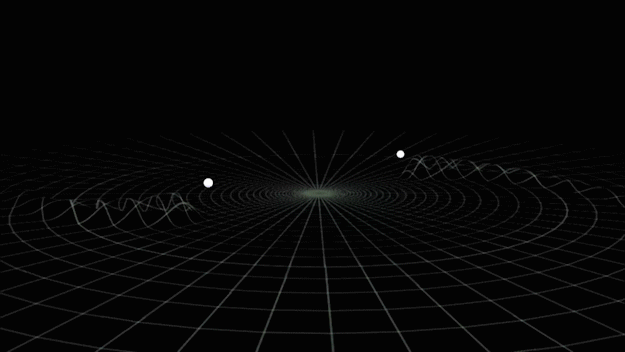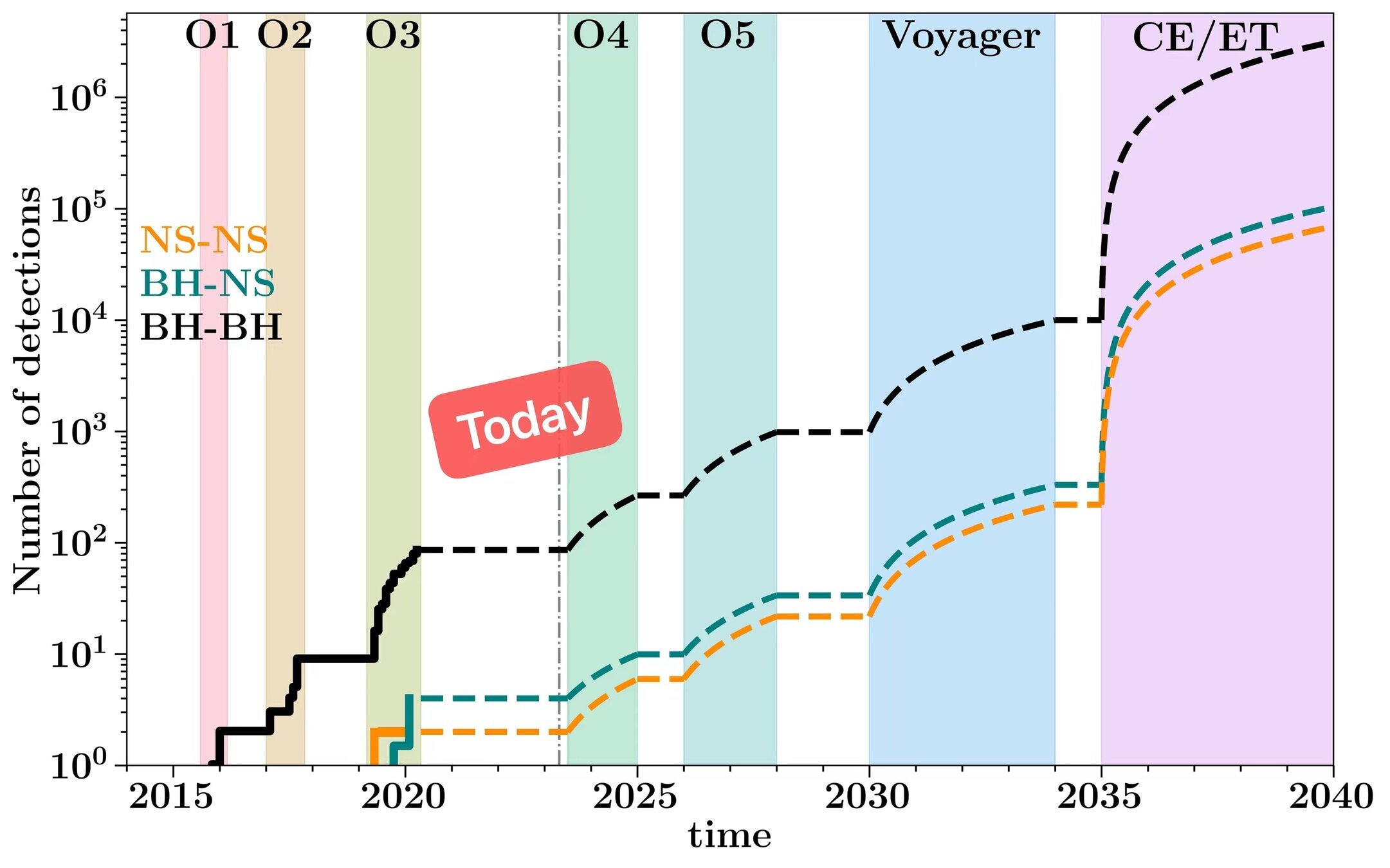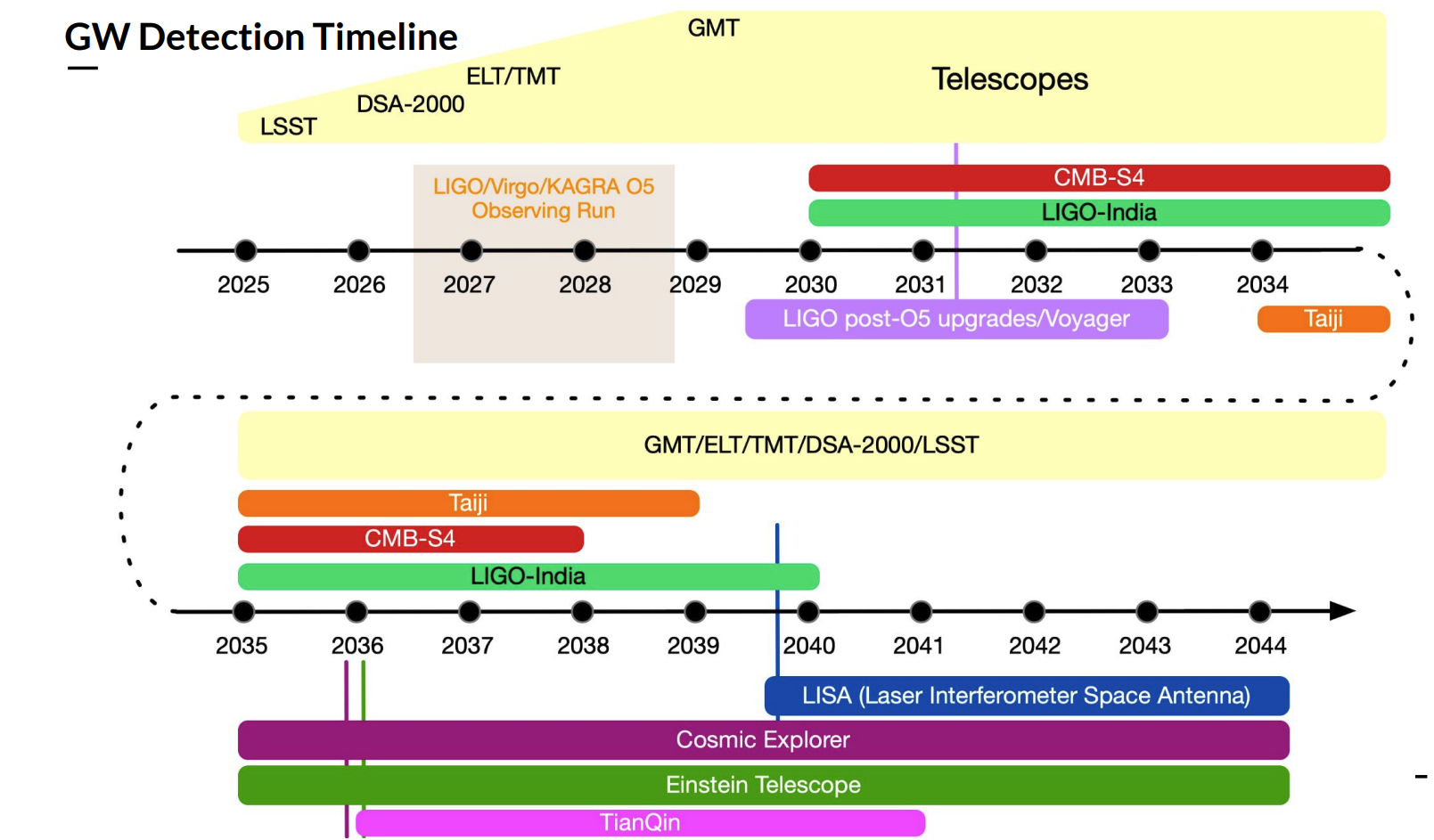2023年6月27日, 15:00-15:30
量子宇宙理论物理研究中心研讨会
引力波探测与AI技术:揭示宇宙奥秘的新手段
王赫
hewang@ucas.ac.cn
中国科学院大学 · 国际理论物理中心(亚太地区)


Gravitational Wave Detection and AI Technology:
New Methods for Unveiling the Mysteries of the Universe
Content
-
Thriving Advancements in AI for GW Astronomy
- GW Searches
- Parameter Estimation
- Noise Characterization
-
Challenge in GW Data Processing: Lessons and Future
- AI: A transformative force driving scientific breakthroughs
-
AI for Science: GW Astronomy
- Interpretability of AI in science
- Key Takeaways


-
In 1916, A. Einstein proposed the GR and predicted the existence of GW.
-
Gravitational waves (GW) are a strong field effect in the GR.
-
2015: the first experimental detection of GW from the merger of two black holes was achieved.
-
2017: the first multi-messenger detection of a BNS signal was achieved, marking the beginning of multi-messenger astronomy.
-
2017: the Nobel Prize in Physics was awarded for the detection of GW.
-
As of now: more than 90 gravitational wave events have been discovered.
-
O4, which began on May 24th 2023, is currently in progress.
-




双星并合系统产生的引力波波源
引力波振幅的测量
地面引力波探测器网络
2017 年诺贝尔物理学奖
Gravitational Wave Astronomy
Gravitational Wave Astronomy
-
Fundamental Physics
- Existence of gravitational waves
- To put constraints on the properties of gravitons
-
Astrophysics
- Refine our understanding of stellar evolution
- and the behavior of matter under extreme conditions.
-
Cosmology
- The measurement of the Hubble constant
- Dark energy
- Detecting gravitational waves require a mix of FIVE key ingredients:
- good detector technology
- good waveform predictions
- good data analysis methodology and technology
- coincident observations in several independent detectors
- coincident observations in electromagnetic astronomy
—— Bernard F. Schutz
DOI:10.1063/1.1629411

©Floor Broekgaarden (repo)

GWTC-3

- AI for Science \(\rightarrow\) AI for GW
- Artificial Intelligence (AI) has great potential to revolutionize gravitational wave astronomy by improving data analysis, modeling, and detector development.




AI for Gravitational Wave



AI for Gravitational Wave
-
GW Data characteristics:
-
Noise: non-Gaussian and non-stationary
-
Signal: A low signal-to-noise ratio (SNR) which is typically about 1/100 of the noise amplitude (-60 dB)
-


Data quality improvement
Credit: Marco Cavaglià
LIGO-Virgo data processing
GW searches
Astrophsical interpretation of GW sources
AI for Gravitational Wave: Searches
Matched-filtering Convolutional Neural Network (MFCNN)

PRD 101, 10 (2020) 104003.

GW150914 的实时信号搜寻
-
The majority of machine learning algorithms used for testing are highly sensitive to non-Gaussian real noise backgrounds, resulting in high false positive rates.





PRD 107, 2 (2023): 023021.

Data quality improvement
Credit: Marco Cavaglià
LIGO-Virgo data processing
GW searches
Astrophsical interpretation of GW sources
AI for Gravitational Wave: Searches
-
Expanding the dimension of the output is to call more information to make decisions in improving AI models.
-
Ensemble learning leverages statistical approaches to utilize more information for making informed decisions by combining multiple models.
PRD 105, 8 (2022) 083013

PRD 107, 6 (2023) 063029


Data quality improvement
Credit: Marco Cavaglià
LIGO-Virgo data processing
GW searches
Astrophsical interpretation of GW sources
AI for Gravitational Wave: Parameter Estimation



Likelihood
-
Traditional parameter estimation (PE) techniques rely on Bayesian analysis methods (posteriors + evidence)
- Computing the full 15-dimensional posterior distribution estimate is very time-consuming:
- Calculating likelihood function
- Template generation time-consuming
- Machine learning algorithms are expected to speed up!

Data quality improvement
Credit: Marco Cavaglià
LIGO-Virgo data processing
GW searches
Astrophsical interpretation of GW sources
AI for Gravitational Wave: Parameter Estimation


- A complete 15-dimensional posterior probability distribution, taking about 1 s (<< \(10^4\) s).
Nature Physics 18, 1 (2022) 112–17
An example: Posterior probability distribution of the complete 15-dimensional parameters

Data quality improvement
Credit: Marco Cavaglià
LIGO-Virgo data processing
GW searches
Astrophsical interpretation of GW sources
AI for Gravitational Wave: Parameter Estimation

Data quality improvement
Credit: Marco Cavaglià
LIGO-Virgo data processing
GW searches
Astrophsical interpretation of GW sources
- Prior Sampling: 50,000 Posterior samples in approximately 8 Seconds.


Big Data Mining and Analytics 5, 1 (2021) 53–63.
-
DINGO (Deep INference for Gravitational wave Observations)
- Tested on 42 BBH events from GWTC-3
- Being deployed for O4, with the potential to become a new gravitational wave signal search pipeline
- Capable of calculating evidence
- Processing time: (using 64 CPU cores)
- less than 1 hour with IMRPhenomXPHM,
- approximately 10 hours with SEOBNRv4PHM
PRL 127, 24 (2021) 241103.
PRL 130, 17 (2023) 171403.
AI for Gravitational Wave: Data Quality Improvement
-
Billion-scale transformer-based model (WaveFormer)
- Suppression on realistic noise, and
- Recovery of injections / GW events
arXiv:2212.14283

BEFORE
AFTER

Data quality improvement
Credit: Marco Cavaglià
LIGO-Virgo data processing
GW searches
Astrophsical interpretation of GW sources
AI for Gravitational Wave: Data Quality Improvement


BEFORE
AFTER
arXiv:2212.14283, DOI: 10.21203/rs.3.rs-2452860/v1
- Billion-scale transformer-based model (WaveFormer)
- Suppression on realistic noise, and
- Recovery of injections / GW events
arXiv:2212.14283

Data quality improvement
Credit: Marco Cavaglià
LIGO-Virgo data processing
GW searches
Astrophsical interpretation of GW sources
AI for Gravitational Wave: Data Quality Improvement
- Billion-scale transformer-based model (WaveFormer)
- Suppression on realistic noise, and
- Recovery of injections / GW events
arXiv:2212.14283


Data quality improvement
Credit: Marco Cavaglià
LIGO-Virgo data processing
GW searches
Astrophsical interpretation of GW sources


Bacon P. et al. arXiv: 2205.13513
AI for Gravitational Wave: Data Quality Improvement
- Billion-scale transformer-based model (WaveFormer)
- Suppression on realistic noise, and
- Recovery of injections / GW events
arXiv:2212.14283


Data quality improvement
Credit: Marco Cavaglià
LIGO-Virgo data processing
GW searches
Astrophsical interpretation of GW sources
AI for Gravitational Wave: Data Quality Improvement
- Billion-scale transformer-based model (WaveFormer)
- Suppression on realistic noise, and
- Recovery of injections / GW events
arXiv:2212.14283


Data quality improvement
Credit: Marco Cavaglià
LIGO-Virgo data processing
GW searches
Astrophsical interpretation of GW sources
Challenge in GW Data Analysis: Lessons and Future
- Space-based GW Observatories (LISA / Taiji / TianQin)


LIGO-G2300554
- Next-Generation Ground-Based GW Observatory (3G: CE / ET)


PLB 841 (2023) 137904.

arXiv: 2207.07414
PRL 130, 17 (2023) 171402.
- Posteriors from AI are generally broader but include the injected value within the 90% confidence interval.
-
AI serves as a valuable tool in gravitational wave astronomy:
(Big data & Computational Complexity)- Enhancing data analysis,
- Noise reduction, and
- Parameter estimation.
- It streamlines the research process and allows scientists to focus on the most relevant information.
-
Beyond a Tool: AI transcends its role as a mere tool by enabling scientific discovery in GW astronomy.
- Characterization of GW signals involves
- Exploring beyond the scope of GR ,
- Enabling real-time inference
- "Curse of Dimensionality" in inference
- Overlapping signal (In progress)
- Hierarchical Bayesian Analysis (In progress)
- Test of GR
- Tighter parameter constraints of variance
- Guaranteed exact coverage
- ...
- Characterization of GW signals involves
Challenge in GW Data Analysis: Lessons and Future

GW170817
GW190412
GW190814

Bayes factor (MCMC)
PRD 101, 10 (2020) 104003.
(In preparation)
Challenge in GW Data Analysis: Lessons and Future

-
AI serves as a valuable tool in gravitational wave astronomy:
(Big data & Computational Complexity)- Enhancing data analysis,
- Noise reduction, and
- Parameter estimation.
- It streamlines the research process and allows scientists to focus on the most relevant information.
-
Beyond a Tool: AI transcends its role as a mere tool by enabling scientific discovery in GW astronomy.
- Characterization of GW signals involves
- Exploring beyond the scope of GR ,
- Enabling real-time inference
- "Curse of Dimensionality" in inference
- Overlapping signal (In progress)
- Hierarchical Bayesian Analysis (In progress)
- Test of GR
- Tighter parameter constraints of variance
- Guaranteed exact coverage
- ...
- Characterization of GW signals involves

arXiv:2305.18528
Challenge in GW Data Analysis: Lessons and Future
-
AI serves as a valuable tool in gravitational wave astronomy:
(Big data & Computational Complexity)- Enhancing data analysis,
- Noise reduction, and
- Parameter estimation.
- It streamlines the research process and allows scientists to focus on the most relevant information.
-
Beyond a Tool: AI transcends its role as a mere tool by enabling scientific discovery in GW astronomy.
- Characterization of GW signals involves
- Exploring beyond the scope of GR ,
- Enabling real-time inference
- "Curse of Dimensionality" in inference
- Overlapping signal (In progress)
- Hierarchical Bayesian Analysis (In progress)
- Test of GR
- Tighter parameter constraints of variance
- Guaranteed exact coverage
- ...
- Characterization of GW signals involves



ICML2023

AI for Science: GW Astronomy
-
Exploring the importance of understanding how AI models make predictions in scientific research.
- The critical role of generative models (生成模型是关键)
- Quantifying uncertainty: a key aspect (不确定性量化问题)
- Fostering controllable and reliable models (模型的可控可信问题)



Bayes
AI
Credit: 李宏毅


Text-to-image

AI for Science: GW Astronomy
-
Exploring the importance of understanding how AI models make predictions in scientific research.
- The critical role of generative models (生成模型是关键)
- Quantifying uncertainty: a key aspect (不确定性量化问题)
- Fostering controllable and reliable models (模型的可控可信问题)


Bayes
AI
Credit: 李宏毅
Text-to-image

Key Takeaways
-
Gravitational-wave astronomy turns to AI:
- A thriving and highly competitive research field on the international stage.
-
Is AI just a tool? Certainly not! It's a revolutionary pathway for scientific discoveries:
- Enabling new discoveries and insights into the universe.
-
Addressing Challenges in AI Interpretability:
- Essential for enhanced discoveries
for _ in range(num_of_audiences):
print('Thank you for your attention! 🙏')This slide: https://slides.com/iphysresearch/zju_20230626

Smith, Rory. Nature Physics 18, 1 (2022): 9–11
Outlook

- 值得关注的 AI 技术:
- Large Language Model (LLM)
- AI generated content (AIGC)

WaveFormer
Transformer: 750x / 2yrs
AI for Science



-
2016年,AlphaGo 第一版发表在了 Nature 杂志上
-
2021年,AI预测蛋白质结构登上 Science、Nature 年度技术突破,潜力无穷
-
2022年,DeepMind团队通过游戏训练AI发现矩阵乘法算法问题
-
《达摩院2022十大科技趋势》将 AI for Science 列为重要趋势
-
“人工智能成为科学家的新生产工具,催生科研新范式”
-
-
AI for Science:为科学带来了模型与数据双驱动的新的研究范式
-
AI + 数学、AI + 化学、AI + 医药、AI + 物理、AI + 天文 ...
-
AlphaGo 围棋机器人
AlphaTensor 发现矩阵算法
AlphaFold 蛋白质结构预测
